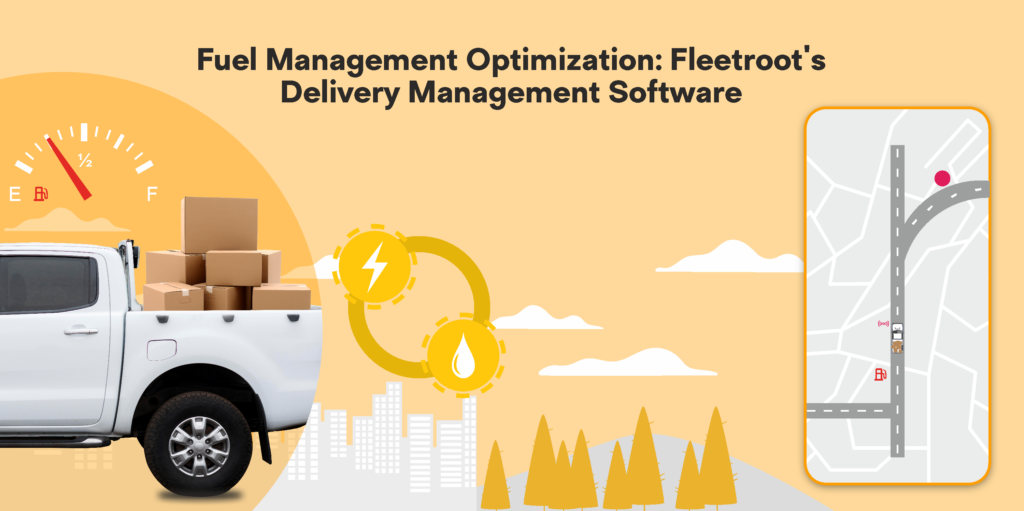Table of Contents:
- Introduction
- Real-Time Updates
- Sensor Monitoring
- Route Diverting
- Operational Excellence through Analytics
- Conclusion
- FAQS
In the dynamic landscape of logistics, where every drop of fuel and every minute on the road count, Fleetroot’s Delivery Management Software emerges as a beacon of efficiency. Armed with a real-time update and sensor monitoring software optimization application, Fleetroot’s Delivery Management Software not only transforms how logistics companies operate but substantiates its impact with tangible data on consumption savings and cost reduction.
The Fuel Consumption Dilemma: A Costly Affair
Fuel consumption remains one of the most significant cost factors for logistics companies, and the conventional approach often involves reactive strategies based on historical data. Fleetroot’s Delivery Management Software recognizes this challenge and steps in with real-time updates that provide an unparalleled level of visibility into fuel consumption patterns.
According to industry data, real-time fuel monitoring can lead to up to 15% reduction in overall fuel costs. Fleet managers equipped with Fleetroot’s data-driven insights can identify specific vehicles or routes contributing to higher consumption and take immediate corrective actions, resulting in substantial savings.
Real-Time Updates: The Numbers Speak
Let’s delve into the impact of Fleetroot’s real-time updates. Consider a fleet of 50 vehicles, each covering an average of 100 miles per day. With real-time updates on fuel consumption, a mere 5% reduction in fuel usage per vehicle translates to a collective saving of over 500 gallons per month.
Now, imagine the financial implications. Let’s say, at an average fuel cost of $3 per gallon, this 5% reduction results in a monthly cost saving of $1,500. Extrapolate this over a year, and logistics companies stand to save a staggering $18,000 – a direct and measurable impact on the bottom line.
Sensor Monitoring: Preventive Savings
The sensor monitoring capabilities offered by Fleetroot’s Delivery Management Software extend beyond real-time updates, delving into the realm of preventive maintenance. Consider this scenario: A vehicle in the fleet experiences
engine inefficiency leading to a 10% increase in fuel consumption. Fleetroot’s sensor monitoring detects this anomaly promptly.
Now, the numbers become crucial. In a fleet covering 100,000 miles per month, a 10% reduction in fuel efficiency equates to an additional consumption of 10,000 gallons. With the average cost per gallon at $3, this inefficiency would result in an extra monthly expenditure of $30,000. Fleetroot’s Delivery Management Software preemptive detection ensures timely maintenance, averting this unnecessary expense and contributing to substantial monthly savings.
Route Diverting: Navigating Cost-Effective Paths
Fleetroot’s route diverting feature takes the data-driven approach a step further by dynamically optimizing routes based on real-time traffic conditions. Let’s explore the savings potential through a tangible example.
Consider a logistics company operating in a metropolitan area where traffic congestion is a daily challenge. Traditional GPS systems may lead vehicles through congested routes, resulting in increased fuel consumption. Fleetroot’s route diverting, by avoiding traffic hotspots, can lead to an estimated 8% reduction in travel time.
In a fleet covering 500,000 miles monthly, this 8% reduction translates to a saving of 40,000 miles. At an average fuel consumption of 7 miles per gallon, Fleetroot’s route optimization results in a monthly reduction of approximately 5,714 gallons. At $3 per gallon, this amounts to a monthly saving of over $17,000.
Operational Excellence Through Analytics: The Strategic Advantage
Fleetroot’s data-driven approach extends to analytics, providing comprehensive insights into various operational aspects. By analyzing key metrics such as delivery times, completion rates, and customer feedback, logistics companies can refine their operations for maximum efficiency.
For instance, an analysis of delivery times might reveal specific time slots or routes consistently leading to longer transit times. Armed with this data, fleet managers can implement strategic changes, optimizing routes for minimal fuel consumption and achieving operational excellence.
The Path Forward: A Strategic Investment
In conclusion, Fleetroot’s real-time update and sensor monitoring software optimization application isn’t just a technological upgrade; it’s a strategic investment backed by concrete data. The numbers tell a compelling story – a story of significant fuel savings, cost reduction, and operational excellence.
As logistics companies navigate the complex terrain of fuel management, Fleetroot stands as a reliable partner, offering a roadmap to efficiency. The impact is measurable, the savings are real, and the future is data-driven. The question now is not just how far your logistics can go with Fleetroot’s Delivery Management Software but how much your logistics can save. It’s not just about miles covered; it’s about dollars saved. The journey begins with Fleetroot.
FAQ
- What is Fleetroot’s Delivery Management Software focus in the logistics industry?
– Fleetroot focuses on revolutionizing fuel management through real-time updates, sensor monitoring, and route diverting to enhance operational efficiency.
- How does Fleetroot’s real-time update feature benefit logistics companies?
– Real-time updates provide live insights into vehicle location, speed, and fuel consumption, allowing fleet managers to make informed decisions and optimize routes dynamically.
- Can Fleetroot’s sensor monitoring prevent potential issues with vehicle performance?
– Yes, Fleetroot’s sensor monitoring detects anomalies in real-time, enabling proactive maintenance to address potential issues and avoid increased fuel consumption.
- What advantages does route diverting bring to fuel efficiency in logistics operations?
– Route diverting minimizes fuel wastage by avoiding traffic congestion and dynamically optimizing routes, resulting in significant fuel savings for logistics operations.
- How does Fleetroot contribute to operational excellence through analytics?
– Fleetroot’s analytics tools provide insights into rider performance, delivery times, completion rates, and customer feedback, enabling data-driven decisions for operational excellence.
- Can Fleetroot help in reducing fuel costs for logistics companies?
– Yes, Fleetroot’s data-driven approach, including real-time updates and route diverting, has shown substantial reductions in fuel costs for logistics companies.
- What distinguishes Fleetroot’s approach to fuel management from traditional methods?
– Fleetroot’s approach is based on real-time data, allowing for dynamic decision-making, proactive maintenance, and route optimization, setting it apart from traditional, static methods.
- Is Fleetroot’s software optimization application suitable for small as well as large fleets?
– Yes, Fleetroot caters to fleets of all sizes, providing scalable solutions to optimize fuel management and operational efficiency.
- What data-driven insights does Fleetroot’s Delivery Management Software provide for route optimization?
– Fleetroot provides real-time traffic updates, allowing for dynamic route diverting, minimizing fuel consumption, and optimizing delivery times based on live conditions.
- How does Fleetroot empower logistics companies to make informed decisions for cost reduction?
– Fleetroot’s comprehensive data insights enable logistics companies to identify inefficiencies, reduce fuel costs, and strategically optimize operations for significant cost reduction.




